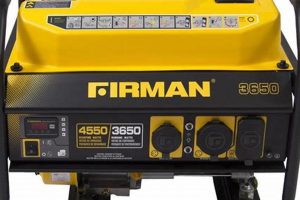Connecting a portable generator to the earth using a grounding rod and wire provides a path for stray electrical currents to dissipate safely. This process typically involves driving a grounding rod into the earth near the generator and connecting it to the generator’s grounding terminal with a properly sized copper wire. A properly grounded generator offers increased protection against electrical shocks.
This safety measure is crucial for preventing electrical hazards. A fault within the generator could energize its metal frame. Without a ground connection, anyone touching the generator could receive a dangerous shock. Proper grounding directs this fault current into the earth, protecting individuals and equipment. Modern electrical codes mandate grounding for portable generators to minimize the risk of electrocution and ensure user safety, reflecting a heightened understanding of electrical safety principles developed over time.
The following sections will detail the specific steps involved in correctly grounding a portable generator, including selecting appropriate grounding materials, connecting the grounding wire, and verifying the ground connection. Additional considerations such as local regulations and specific generator requirements will also be addressed.
Grounding a Portable Generator
Safe operation requires careful attention to grounding procedures. The following tips provide crucial guidance for establishing a secure ground connection, minimizing risks associated with electrical faults.
Tip 1: Consult the Generator’s Manual: Always refer to the manufacturer’s instructions for specific grounding requirements. Different models may have unique specifications.
Tip 2: Use Appropriate Grounding Materials: Utilize a copper grounding rod and wire specifically designed for grounding electrical systems. Select the correct gauge wire as recommended by the manufacturer or local electrical codes.
Tip 3: Choose a Suitable Location for the Grounding Rod: Drive the grounding rod into moist earth for optimal conductivity. Avoid areas with underground utilities.
Tip 4: Drive the Rod Deep Enough: Ensure the grounding rod is driven firmly into the earth, leaving only a few inches exposed. This provides a solid, reliable ground connection.
Tip 5: Securely Connect the Grounding Wire: Use an appropriate clamp or connector to attach the grounding wire to both the grounding rod and the generator’s grounding terminal. Ensure a tight, corrosion-resistant connection.
Tip 6: Inspect the Grounding System Regularly: Periodically check the grounding wire and rod for damage or corrosion. Replace any compromised components immediately.
Tip 7: Adhere to Local Electrical Codes: Ensure all grounding procedures comply with local regulations and national electrical codes. Consult a qualified electrician if necessary.
Tip 8: Test the Ground: If unsure about the effectiveness of the ground, use a ground tester to verify the connection’s integrity.
By adhering to these guidelines, the risks associated with operating a portable generator are significantly reduced, ensuring both personal safety and equipment protection.
Understanding and implementing these grounding procedures is paramount for safe and effective portable generator operation.
1. Safety
Establishing a secure ground connection is paramount for safe portable generator operation. This practice safeguards against electrical shocks stemming from faults within the generator. Without proper grounding, a fault can energize the generator’s metallic frame, posing a severe shock hazard to anyone coming into contact with it. The ground connection provides a low-resistance path for fault currents to flow directly into the earth, preventing dangerous voltage buildup on the generator’s accessible surfaces. For instance, if a wire inside the generator frays and touches the frame, the ground connection will immediately divert the current, preventing a potential electrocution hazard.
The practical significance of grounding lies in its ability to mitigate the risk of serious injury or even fatality. Consider a scenario where a generator is powering essential appliances during a power outage. A ground fault in an ungrounded generator could energize the frame. If someone touches the generator while simultaneously in contact with a grounded object, such as a plumbing fixture, they could complete the electrical circuit, resulting in a potentially lethal shock. Proper grounding prevents this hazardous scenario by providing a direct path for the fault current to flow into the earth, bypassing the individual. This fundamental safety measure underscores the critical connection between proper grounding and operator well-being.
Effective grounding is not merely a recommended practice; it is a mandatory safety requirement enshrined in electrical codes and standards. These regulations reflect a deep understanding of electrical safety principles and the potential dangers of ungrounded electrical equipment. By adhering to these standards and prioritizing proper grounding procedures, individuals can significantly reduce the risk of electrical accidents associated with portable generator operation, ensuring personal safety and preventing potentially tragic outcomes.
2. Grounding Rod
The grounding rod forms a critical component of a portable generator’s grounding system, providing a direct electrical connection to the earth. Its primary function is to create a low-resistance path for fault currents to dissipate harmlessly, preventing dangerous electrical shocks. Selecting and installing the grounding rod correctly is essential for ensuring the overall effectiveness of the grounding system.
- Material and Dimensions
Grounding rods are typically made of copper-clad steel or solid copper, chosen for their excellent conductivity and corrosion resistance. The rod’s diameter and length influence its effectiveness in dissipating fault currents. A longer rod provides a larger contact area with the earth, reducing resistance and enhancing current flow. Local electrical codes often specify minimum dimensions for grounding rods, ensuring adequate performance under fault conditions. For instance, the National Electrical Code (NEC) in the United States typically requires a minimum length of 8 feet for grounding rods.
- Installation
Proper installation is crucial for achieving a reliable ground connection. The rod must be driven deeply into the earth, ideally in an area with moist soil to maximize conductivity. Rocky or dry soil can impede the rod’s ability to dissipate current effectively. The top of the rod should remain a few inches above ground level for connection to the grounding wire. Specialized tools, such as a sledgehammer or a powered rod driver, facilitate proper installation, ensuring a secure and long-lasting connection to the earth.
- Connection to the Generator
A dedicated grounding wire, typically copper, connects the generator’s grounding terminal to the grounding rod. This wire must be appropriately sized to handle potential fault currents without overheating or melting. A secure, corrosion-resistant connection is crucial for maintaining the integrity of the grounding path. Approved connectors or clamps ensure a tight bond between the wire and the rod, preventing loosening or detachment over time.
- Role in Electrical Safety
The grounding rod’s function in electrical safety is paramount. It provides the essential pathway for fault currents to flow safely into the earth, protecting individuals and equipment from dangerous electrical potentials. Without a properly installed grounding rod, the generator’s frame could become energized during a fault, posing a significant risk of electrocution. The grounding rod effectively neutralizes this hazard, diverting the current away from the generator and preventing potentially fatal consequences. For example, if a power surge occurs, the grounding rod will effectively channel the excess energy into the ground, minimizing the risk of equipment damage or fire.
These facets of the grounding rod highlight its crucial role within the broader context of portable generator grounding. A properly selected, installed, and maintained grounding rod ensures the system’s efficacy, providing a reliable path for fault currents and significantly reducing the risks associated with generator operation. Neglecting any aspect of the grounding rod’s installation or maintenance compromises overall safety, potentially leading to hazardous situations. Therefore, understanding the grounding rod’s function and ensuring its proper integration into the grounding system is essential for safe and responsible generator use.
3. Grounding Wire
The grounding wire represents a critical link in the safe operation of a portable generator, bridging the generator’s frame to the grounding rod and facilitating a secure path for fault currents to dissipate into the earth. Its selection, installation, and maintenance are integral to the effectiveness of the overall grounding system, impacting the safety of both individuals and equipment.
- Material and Gauge
Copper wire is the standard choice for grounding portable generators due to its high conductivity and corrosion resistance. The wire’s gauge, a measure of its thickness, dictates its current-carrying capacity. A thicker wire (lower gauge number) can safely handle larger fault currents. Using an undersized wire risks overheating and potential failure during a fault, negating the grounding system’s protective function. Consulting the generator’s manual or local electrical codes clarifies the appropriate wire gauge for specific applications. For example, a #10 AWG copper wire might be suitable for smaller generators, while larger units might necessitate a #6 AWG or thicker.
- Connection and Clamps
Establishing secure connections at both ends of the grounding wire is essential for maintaining a continuous grounding path. Approved grounding clamps, designed to bite firmly into the conductor and grounding rod, ensure a tight, lasting connection. Corrosion-resistant connectors are crucial for preventing the degradation of the connection over time, particularly in outdoor environments. Loose or corroded connections can interrupt the grounding path, rendering the system ineffective and creating a potential shock hazard. Regular inspection of the connections for tightness and signs of corrosion is crucial for ongoing safety.
- Length and Routing
The length of the grounding wire should be kept as short as practically possible to minimize resistance. Excessive length can increase the wire’s impedance, reducing its effectiveness in diverting fault currents. The wire should be routed away from potential hazards, such as moving parts or excessive heat sources, to prevent damage and maintain its integrity. Proper routing also minimizes tripping hazards and ensures the wire remains readily accessible for inspection and maintenance. For instance, routing the wire along the generator’s frame and securing it with clips can prevent accidental damage and maintain a tidy installation.
- Importance in Fault Current Dissipation
The grounding wire’s primary role lies in its ability to conduct fault currents safely to the grounding rod and subsequently into the earth. This rapid diversion of current protects individuals from electric shock by preventing the generator’s frame from becoming energized. It also safeguards connected equipment from damage caused by voltage surges. The grounding wire effectively acts as a safety valve, diverting potentially harmful electrical energy away from sensitive electrical components and ensuring the safety of those operating or in proximity to the generator. Without a properly installed grounding wire, a fault within the generator could result in dangerous voltage levels on exposed metal parts, potentially leading to serious injury.
These facets of the grounding wire underscore its crucial role in the proper functioning of a portable generator’s grounding system. A correctly selected, installed, and maintained grounding wire ensures an uninterrupted low-resistance path for fault currents, minimizing the risks associated with generator operation and safeguarding both individuals and equipment. Ignoring any aspect of the grounding wire’s installation or maintenance jeopardizes safety and can lead to potentially hazardous situations. Understanding and correctly implementing these principles ensures the grounding system’s effectiveness, making portable generator use significantly safer.
4. Connection
The secure connection between the grounding wire, grounding rod, and generator forms the crucial final step in establishing a safe grounding system. This connection facilitates the uninterrupted flow of fault currents away from the generator and into the earth, the fundamental principle behind mitigating electrical shock hazards. A properly executed connection ensures the grounding system’s effectiveness, while a compromised connection negates the entire system’s purpose, rendering it useless in a fault scenario. For example, a loose connection at the grounding rod can introduce significant resistance, impeding the flow of fault current and potentially energizing the generator’s frame, creating a shock hazard.
The practical significance of a secure connection becomes evident during a ground fault. Imagine a scenario where a faulty appliance connected to the generator develops a short circuit. With a robust grounding system and secure connections, the fault current flows safely through the grounding wire and rod into the earth. However, a loose or corroded connection can interrupt this path, causing the fault current to seek alternative routes, potentially through an individual touching the generator, resulting in a dangerous shock. The integrity of the connection directly impacts the system’s ability to protect against such hazards, highlighting its critical role in overall safety. Furthermore, consider a construction site where a generator powers electric tools. A secure ground connection is essential to protect workers who may be handling these tools in potentially damp conditions, further emphasizing the practical implications of a properly established ground.
Ensuring a tight, corrosion-resistant connection involves using appropriate clamps specifically designed for grounding applications. These clamps create a secure bond between the grounding wire and both the generator’s grounding terminal and the grounding rod. Regular inspection and maintenance of these connections are paramount. Over time, environmental factors such as moisture and temperature fluctuations can contribute to corrosion or loosening, compromising the connection’s integrity. Periodic tightening and cleaning of the connections, or replacement if necessary, maintain the grounding system’s long-term effectiveness. This proactive approach to connection maintenance minimizes the risk of ground faults and their potentially hazardous consequences, ensuring the continued safe operation of the portable generator. Therefore, the connection represents not merely a final step but a continuous responsibility in maintaining a safe operating environment.
5. Testing
Testing a portable generator’s grounding system is a crucial safety measure that verifies the effectiveness of the grounding path. This process confirms that fault currents will flow safely to ground, protecting individuals and equipment from electrical hazards. A properly functioning grounding system provides a low-resistance path for these currents, preventing dangerous voltage buildup on the generator’s frame. Testing ensures this path is intact and capable of performing its intended function. Without testing, one cannot definitively ascertain the grounding system’s integrity, leaving potential safety risks unaddressed. For example, a seemingly well-grounded generator might have a corroded connection hidden beneath the surface, significantly impeding current flow and creating a shock hazard during a fault. Testing unveils such hidden deficiencies.
The practical significance of testing becomes evident in scenarios where ground faults occur. Consider a generator powering critical equipment during a power outage. A fault within the generator or a connected appliance can create a hazardous situation. A properly tested grounding system ensures that the fault current is safely diverted to ground, preventing dangerous voltages on exposed metal parts. Without testing, there’s no guarantee that the grounding system will function as intended, potentially exposing individuals to electric shock. Regular testing provides peace of mind, assuring users that the grounding system is ready to perform its protective function. In a construction setting, for instance, where generators power various tools, regular grounding system testing is essential for worker safety, particularly when operating in wet conditions.
Various methods exist for testing grounding systems, ranging from simple continuity checks to more sophisticated measurements using specialized equipment. A basic continuity test involves using a multimeter to measure the resistance between the generator’s grounding terminal and the grounding rod. A low resistance reading indicates a sound connection. More advanced tests, such as those performed with a ground resistance tester, provide precise measurements of the grounding system’s resistance to earth. Regardless of the method used, regular testing, especially before initial use and after any modifications to the grounding system, is essential for ensuring continued safety. Addressing any identified issues promptly, such as replacing a corroded clamp or improving the ground connection, maintains the grounding system’s effectiveness and minimizes potential risks. Therefore, testing is not merely a precautionary step but an ongoing commitment to ensuring the safe operation of a portable generator.
6. Regulations
Adherence to established regulations is paramount when grounding a portable generator. These regulations, often codified in local electrical codes and national standards like the National Electrical Code (NEC) in the United States, provide critical safety guidelines for grounding electrical systems. They ensure the grounding system’s effectiveness in mitigating electrical hazards, protecting individuals and equipment from potential harm. Ignoring these regulations not only compromises safety but can also lead to legal repercussions. These regulations reflect a collective understanding of electrical safety principles, incorporating best practices and lessons learned from past incidents. They provide a framework for safe generator operation, minimizing the risk of accidents and ensuring compliance with established safety standards.
- National Electrical Code (NEC)
The NEC serves as a benchmark for electrical safety in the United States. Specific articles within the NEC address portable generator grounding, dictating requirements for grounding electrodes, conductors, and connection methods. These stipulations ensure the grounding system’s adequacy in handling potential fault currents. For instance, the NEC specifies minimum sizes for grounding conductors based on the generator’s output capacity, ensuring they can safely carry the fault current without overheating. Adherence to NEC guidelines is essential for maintaining a safe electrical environment and ensuring compliance with national safety standards.
- Local Electrical Codes
Local jurisdictions often supplement national codes with specific requirements tailored to regional conditions. These codes might address unique environmental factors or specific grounding practices relevant to the area. Consulting local authorities or qualified electricians clarifies these requirements, ensuring compliance and promoting a safe operating environment. For example, areas with high soil resistivity might require longer grounding rods or specific grounding electrode configurations to achieve effective grounding. Adherence to local codes ensures the grounding system is suitable for the specific environment, enhancing safety and preventing potential hazards.
- Occupational Safety and Health Administration (OSHA)
In occupational settings, OSHA regulations play a significant role in ensuring worker safety around electrical equipment, including portable generators. OSHA mandates compliance with established grounding practices to protect employees from electrical hazards. These regulations emphasize proper grounding procedures, training, and the use of appropriate safety equipment. For example, OSHA might require employers to provide ground fault circuit interrupters (GFCIs) for generator outlets used in construction or other outdoor work environments, further enhancing safety measures. Adherence to OSHA guidelines minimizes workplace accidents and promotes a safe work environment.
- Manufacturer’s Instructions
While adhering to national and local codes is crucial, generator manufacturers often provide specific grounding instructions tailored to their equipment. These instructions might include details on grounding electrode requirements, conductor sizes, or recommended connection methods. Consulting the manufacturer’s manual ensures compatibility between the grounding system and the generator, optimizing safety and performance. For instance, a manufacturer might recommend a specific type of grounding clamp for use with their generator, ensuring a secure and reliable connection. Following these instructions ensures the grounding system effectively complements the generator’s design, minimizing potential risks and maximizing safety.
These regulatory facets underscore the importance of compliance when grounding a portable generator. Adherence to these guidelines ensures a safe and effective grounding system, protecting individuals and equipment from electrical hazards. Regulations provide a framework for safe generator operation, reflecting industry best practices and codified safety principles. Neglecting these regulations not only compromises safety but also undermines legal compliance, potentially leading to serious consequences. Therefore, understanding and adhering to these regulations is not merely a recommendation but a fundamental responsibility for anyone operating a portable generator.
7. Maintenance
Maintaining a portable generator’s grounding system is essential for ensuring its long-term effectiveness and safety. Grounding systems, while robustly designed, are susceptible to environmental factors and wear over time. Neglecting maintenance can compromise the system’s integrity, increasing the risk of electrical hazards. A well-maintained grounding system provides a reliable path for fault currents to flow safely to the earth, protecting individuals and equipment. Conversely, a poorly maintained system can create a dangerous situation, potentially allowing the generator’s frame to become energized during a fault. For instance, corrosion on the grounding rod or a loose connection at the generator’s grounding terminal can significantly increase resistance, impeding the flow of fault current and creating a shock hazard. Regular maintenance mitigates these risks, preserving the grounding system’s protective capabilities. One practical example of this is a generator used for backup power during outages. A corroded grounding rod might not be apparent during normal operation, but during a fault, the increased resistance could create a dangerous voltage on the generator’s frame, posing a significant risk to anyone touching it.
Practical maintenance involves periodic inspections and necessary corrective actions. Inspecting the grounding rod for corrosion and ensuring it remains firmly embedded in the earth are crucial steps. Checking the grounding wire for damage, fraying, or loose connections at both the generator and the grounding rod ensures a continuous, low-resistance path. Tightening or replacing clamps as needed maintains secure connections. In environments with high salinity or corrosive soils, more frequent inspections and potentially the use of corrosion-resistant materials might be necessary. Consider a coastal application where saltwater exposure accelerates corrosion. Regularly cleaning and inspecting the grounding rod and connections, and potentially employing stainless steel hardware, can mitigate these corrosive effects, ensuring the grounding system’s longevity and effectiveness.
Maintaining a generator’s grounding system is not merely a preventative measure; it’s a fundamental aspect of electrical safety. It directly impacts the system’s ability to protect against ground faults, mitigating the risk of electrical shock and equipment damage. Regular maintenance, combined with adherence to established grounding procedures and regulations, ensures the grounding system remains a reliable safeguard, contributing to the overall safety and proper operation of the portable generator. Ignoring these crucial maintenance steps undermines the entire grounding system, potentially leading to hazardous situations and negating the inherent safety benefits of a properly grounded generator. Therefore, incorporating routine maintenance into the overall generator operation protocol is essential for ensuring a safe and reliable power source.
Frequently Asked Questions About Generator Grounding
Proper grounding is crucial for safe generator operation. This FAQ section addresses common inquiries regarding the grounding process, clarifying potential uncertainties and reinforcing key safety principles.
Question 1: Why is grounding a portable generator necessary?
Grounding provides a safe path for stray electrical currents to dissipate into the earth, preventing potentially lethal shocks in the event of a fault.
Question 2: What type of grounding rod is recommended?
Copper-clad steel or solid copper rods are typically recommended due to their conductivity and corrosion resistance. Local codes often specify minimum dimensions.
Question 3: What gauge wire should be used for the grounding connection?
The appropriate wire gauge depends on the generator’s capacity. Consulting the generator’s manual or local electrical codes provides specific guidance.
Question 4: How deep should the grounding rod be driven into the ground?
The rod should be driven deeply enough to ensure a firm connection, leaving only a few inches exposed above ground. Local codes often specify minimum depths.
Question 5: How often should the grounding system be inspected?
Regular inspections are essential, especially in corrosive environments. Checking connections for tightness and corrosion, and inspecting the rod’s condition, helps ensure ongoing safety.
Question 6: Can a generator be grounded without a grounding rod?
While alternative grounding methods might exist in specific situations, using a dedicated grounding rod is the generally accepted and safest practice for portable generators, ensuring a reliable path to earth.
Understanding and implementing proper grounding procedures is paramount for safe generator operation. These practices safeguard against electrical hazards, ensuring both operator well-being and equipment protection.
For further information and detailed guidance, consult local electrical codes and the generator manufacturer’s instructions.
Grounding a Portable Generator
Safe and effective portable generator operation necessitates a comprehensive understanding of grounding principles. This exploration has detailed the critical aspects of establishing a secure grounding system, encompassing the selection of appropriate materials, proper connection techniques, and adherence to relevant safety regulations. Prioritizing these procedures mitigates significant electrical hazards, safeguarding individuals and equipment from potential harm. Regular inspection and maintenance further ensure the grounding system’s long-term effectiveness, reinforcing its protective function.
Electrical safety is paramount. Implementing these grounding practices is not merely a recommendation but a fundamental responsibility. Neglecting these critical safety measures jeopardizes well-being and undermines the reliability of the power supply. A thorough grasp of these principles empowers informed decisions, fostering a secure operating environment and promoting responsible generator usage.






